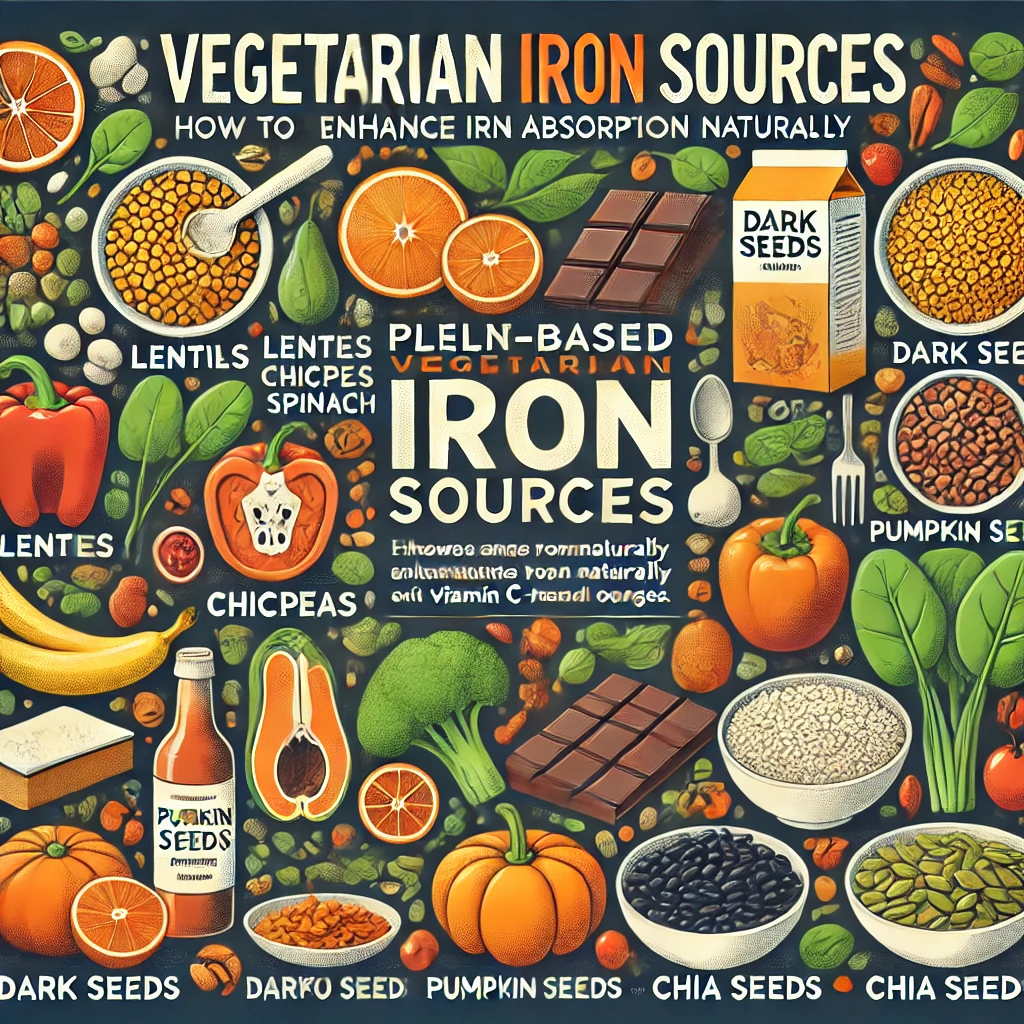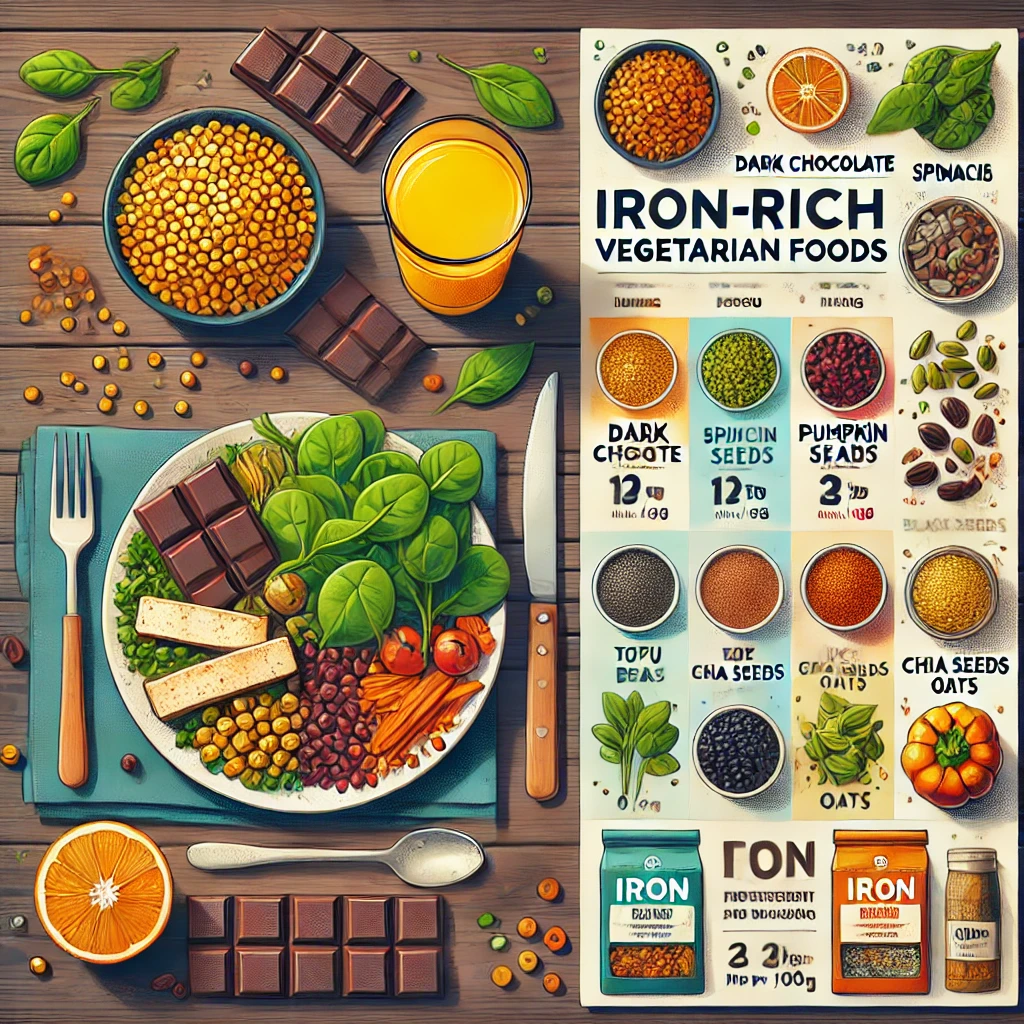Table of Contents
| Section | Title |
|---|---|
| 1 | Introduction |
| 2 | Why Iron is Essential for Your Body |
| 3 | Symptoms of Iron Deficiency |
| 4 | Types of Iron: Heme vs. Non-Heme |
| 5 | Top 10 Iron-Rich Foods for Vegetarians |
| 6 | How to Enhance Iron Absorption Naturally |
| 7 | Foods That Inhibit Iron Absorption |
| 8 | Meal Planning for Optimal Iron Intake |
| 9 | Iron Supplements: When and Why You Might Need Them |
| 10 | FAQs |
| 11 | Conclusion |

1. Introduction
Iron is a vital nutrient that plays a key role in transporting oxygen throughout the body. Many people believe that vegetarians struggle to get enough iron, but with proper meal planning and knowledge, you can meet your daily requirements effortlessly. This guide explores effective strategies to maintain healthy iron levels on a vegetarian diet.
2. Why Iron is Essential for Your Body
Iron is crucial for producing hemoglobin, the protein in red blood cells that carries oxygen. It also supports immune function, energy production, and cognitive development. Iron deficiency can lead to fatigue, weakness, and impaired concentration.
3. Symptoms of Iron Deficiency
Some common symptoms include:
- Fatigue and weakness
- Shortness of breath
- Pale skin
- Brittle nails
- Headaches and dizziness
- Cold hands and feet
- Restless legs syndrome
If you experience these symptoms, consider increasing your iron intake and consulting a healthcare professional.
4. Types of Iron: Heme vs. Non-Heme
There are two types of dietary iron:
- Heme Iron (Found in animal products)
- Non-Heme Iron (Found in plant-based foods)
Vegetarians rely on non-heme iron, which is absorbed less efficiently than heme iron. However, there are ways to improve absorption, which we’ll discuss below.
5. Top 10 Iron-Rich Foods for Vegetarians
Here are some of the best plant-based sources of iron:
| Food | Iron Content (per 100g) |
|---|---|
| Lentils | 3.3 mg |
| Chickpeas | 2.9 mg |
| Tofu | 5.4 mg |
| Spinach | 2.7 mg |
| Pumpkin Seeds | 4.2 mg |
| Quinoa | 1.5 mg |
| Dark Chocolate (70%+) | 11.9 mg |
| Black Beans | 2.5 mg |
| Chia Seeds | 7.7 mg |
| Oats | 4.7 mg |
6. How to Enhance Iron Absorption Naturally
To boost your body’s ability to absorb iron:
- Pair iron-rich foods with vitamin C (e.g., citrus fruits, bell peppers, strawberries).
- Cook with cast iron cookware, which can increase iron content in food.
- Avoid drinking tea or coffee with meals, as tannins inhibit iron absorption.
7. Foods That Inhibit Iron Absorption
Some foods can interfere with iron absorption:
- Calcium-rich foods (e.g., dairy products)
- Tannins (found in tea, coffee, and red wine)
- Phytates (found in whole grains and legumes)
To maximize absorption, consume these foods at different times from iron-rich meals.
8. Meal Planning for Optimal Iron Intake
Here’s a sample iron-rich vegetarian meal plan:
Breakfast: Oatmeal with chia seeds, walnuts, and strawberries.
Lunch: Lentil salad with spinach, quinoa, and lemon dressing.
Snack: Dark chocolate with a handful of almonds.
Dinner: Stir-fried tofu with bell peppers and brown rice.
9. Iron Supplements: When and Why You Might Need Them
If you struggle to meet your iron needs through diet alone, supplements may be necessary. Consult a healthcare professional before taking iron supplements to avoid overdose risks, such as constipation or nausea.
10. FAQs
Q1: Can you get enough iron from a vegetarian diet?
Yes! By eating a variety of iron-rich plant foods and enhancing absorption, you can meet your daily iron needs.
Q2: How much iron do I need daily?
- Adult men: 8 mg
- Adult women (19-50 years): 18 mg
- Pregnant women: 27 mg
- Postmenopausal women: 8 mg
Q3: What are the best vegetarian sources of iron?
Lentils, chickpeas, tofu, spinach, pumpkin seeds, quinoa, and dark chocolate are excellent sources.
Q4: Does cooking affect iron levels in food?
Yes. Cooking in cast iron pans can increase the iron content of your food.
Q5: Can too much iron be harmful?
Yes. Excess iron can lead to digestive issues and organ damage. Always stick to recommended intake levels.
Q6: How can I improve my iron levels quickly?
Consume iron-rich foods with vitamin C, avoid inhibitors like tea and coffee during meals, and consider supplements if necessary.
11. Conclusion
Getting enough iron on a vegetarian diet is entirely possible with proper meal planning. Incorporate iron-rich foods, enhance absorption with vitamin C, and be mindful of inhibitors. By following these strategies, you can maintain optimal iron levels and enjoy a healthy, balanced diet.
🚀 Let’s Connect!
Looking for expert insights on website development, SEO, and online business growth? Connect with me on LinkedIn or reach out via my website!
🔗 Connect on LinkedIn 📩 Contact Me



